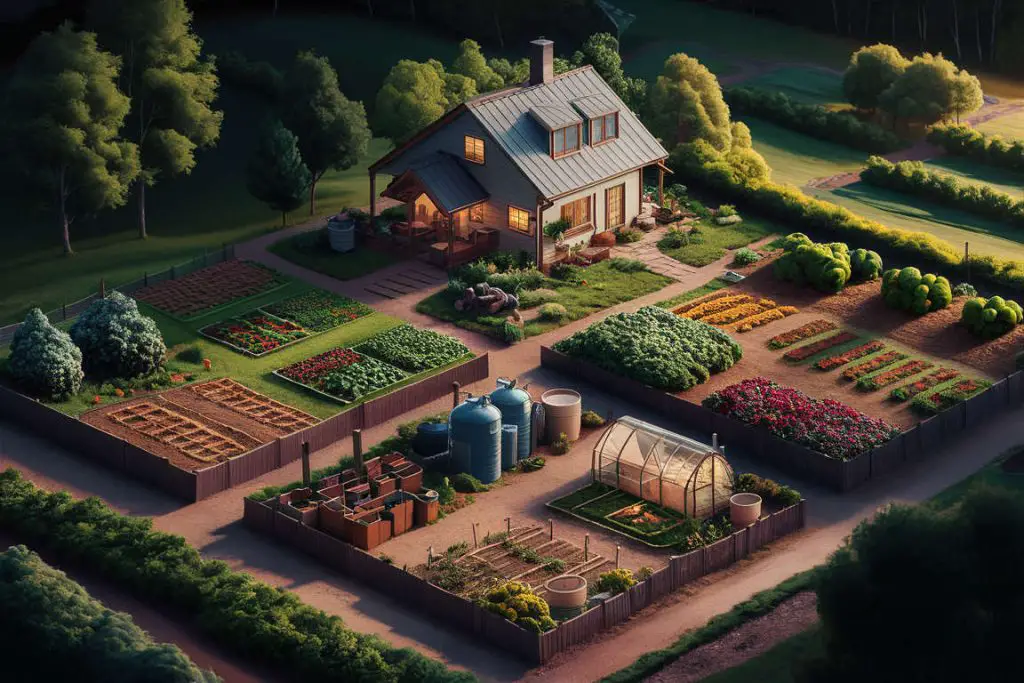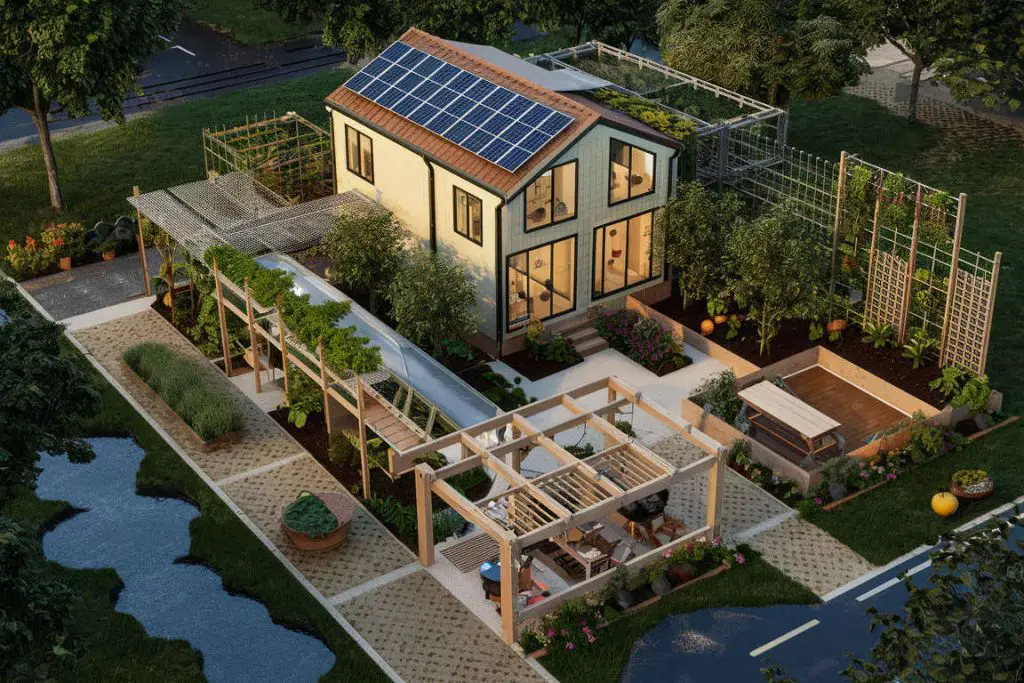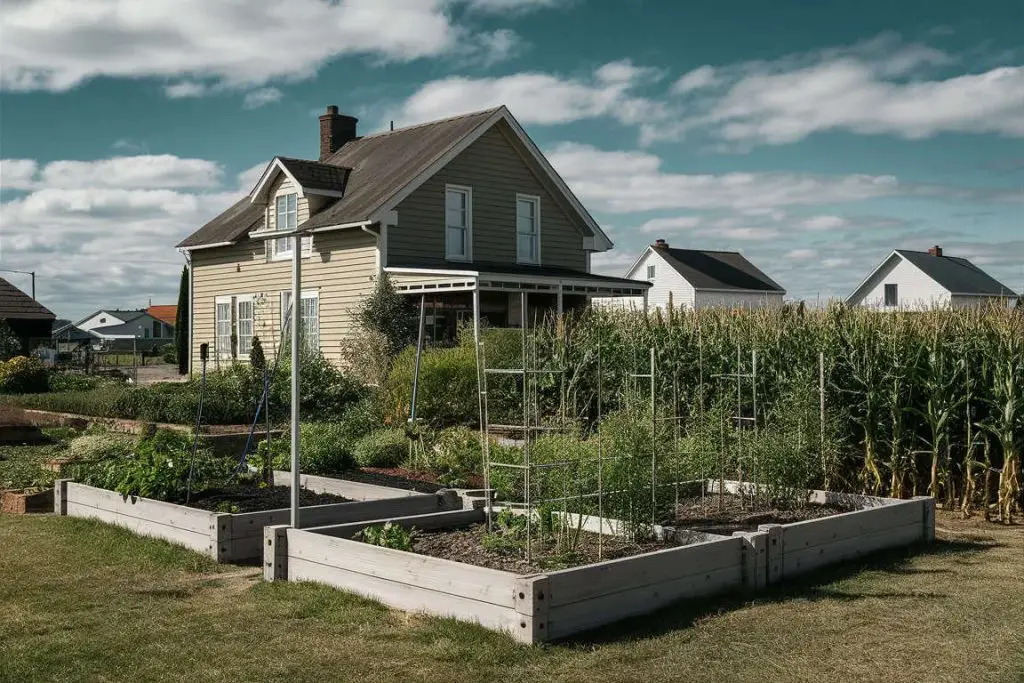Mastering Homesteading: Thriving Sustainably within One Quarter Acre of the Earth
When designing layouts for homesteading on a quarter-acre (approximately 4050 square feet), it’s essential to balance the requirements for agriculture, housing, and amenities while also considering the efficient use of space. Here are three effective layout designs:
Layout 1: The Balanced Homestead

This balanced approach divides land into four primary sections – each with a specific purpose.
- Housing (approx. 850 square feet): Construct a small, eco-friendly house on one side of the quarter-acre property to provide shelter and living space for the homesteaders. Utilize passive solar design principles to minimize energy needs.
- Agriculture (approx. 1500 square feet): Incorporate raised beds, a small vegetable garden, fruit trees, and berry bushes in this area, dividing it into several plots for various crops. This layout facilitates crop rotation, promotes natural pest control and reduces water use through targeted irrigation systems like drip lines or soaker hoses.
- Water Storage (approx. 300 square feet): Designate a space near the property’s edge for rainwater collection and storage tanks to ensure a reliable supply of fresh water throughout the year, reducing reliance on external sources and minimizing transportation costs.
- Gardening & Workspace (approx. 450 square feet): Allocate a smaller plot near the house where tools can be stored, compost bins placed for easy access, and a small greenhouse or cold frame to extend growing seasons while conserving energy usage.
This layout provides a balanced approach that optimizes space allocation between essential needs without overly compromising any single area’s functionality.
Layout 2: The Urban Homestead

The urban homestead is designed around maximizing green spaces, vertical gardening, and minimizing energy usage within the constraints of a quarter-acre property.
- Housing (approx. 800 square feet): Build an eco-friendly house with high insulation levels, large windows for natural lighting, and possibly solar panels to offset electricity needs. The compact design allows minimal space usage while maintaining living standards.
- Agriculture & Green Spaces (approx. 1600 square feet): Implement vertical gardening systems using trellises, wall planters, and greenhouse structures. These techniques maximize plant growing space in a small area while providing additional shade and insulation for the house. Plant fruit trees at optimal locations to take advantage of their larger root zones within available ground space.
- Water Storage & Drainage (approx. 50 square feet): Designate an area near the property’s edge for a rain garden, which not only provides water storage but also helps manage stormwater runoff naturally while supporting local biodiversity and reducing soil erosion. Additionally, install permeable paving materials to reduce surface runoff and encourage groundwater recharge.
- Workspace & Recreation (approx. 100 square feet): Dedicate a small space near the house for composting, tools storage, and recreational activities like yoga or meditation. Incorporating green elements such as potted plants can enhance air quality and psychological well-being while conserving energy.
This layout focuses on maximizing vertical gardening techniques to optimize space usage and promote self-sufficiency without compromising the eco-friendliness of the homestead.
Layout 3: The Multi-Functional Homestead

In this approach, each element is designed with multiple functions in mind while ensuring energy and water conservation throughout the property.
- Housing (approx. 750 square feet): Construct a sustainable house using passive solar design principles to minimize heating and cooling needs. Additional features like insulated walls, low-emissivity windows, and efficient HVAC systems help further reduce energy consumption.
- Agriculture (approx. 1700 square feet): Implement a mixed farming approach that incorporates both annual and perennial crops to maximize yield while conserving space. Include greenhouses, fruit trees, berry bushes, vegetable gardens, and composting areas. Utilize efficient irrigation systems like drip or sub-surface methods for water conservation.
- Water Storage & Recycling (approx. 400 square feet): Design a rainwater collection system with storage tanks near the property’s edge, as well as a small greywater recycling system to collect and reuse household wastewater for irrigation purposes. This setup helps ensure an adequate water supply throughout the year while minimizing the environmental impact of excessive groundwater use.
- Workspace & Recreation (approx. 200 square feet): Construct a multipurpose structure that serves as both a greenhouse and workshop/living space, incorporating vertical gardening techniques for food production while providing storage for tools, equipment, and personal items. This compact design ensures maximum utilization of available land without sacrificing functionality.
This layout prioritizes flexibility by integrating various elements that serve multiple purposes while maintaining energy and water conservation throughout the homestead.
Factors to Consider when Homesteading in Small Areas

Above, we have provided a few various layout options to consider if you have small or limited space for homesteading. There are though some essential factors to consider that relate to homesteading with limited space.
Maximize Space Utilization
Small spaces require efficient use of every square foot. Employ vertical gardening techniques, such as raised beds, trellises and wall planters for growing crops like tomatoes, beans, or vining fruits. Use raised beds to increase soil quality and improve accessibility.
Composting
Implement a compost pile or bin near your home to recycle food waste into nutrient-rich soil amendments for your garden. Composting not only reduces the need for chemical fertilizers but also saves space by utilizing organic materials that might otherwise be discarded.
Maintain a Diverse Diet
Plant a variety of crops in small spaces to ensure a balanced and nutrient-rich diet for your family, promoting overall health and wellbeing on the homestead.
Energy Efficiency
Emphasize passive solar design principles when constructing or retrofitting housing structures. Incorporate features like south-facing windows to capture natural sunlight while minimizing cooling needs during warmer months. Insulate walls and ceilings, add energy-efficient appliances, and consider renewable energy sources such as solar panels for electricity production.
Water Conservation
Implement water-saving techniques like rainwater collection systems, drip irrigation, or soaker hoses to efficiently utilize limited water resources. Plant drought-tolerant and native crops that require less water to grow successfully in small areas while reducing reliance on external sources.
Integrated Pest Management (IPM)
Employ a combination of natural pest control methods, such as companion planting, crop rotation, and habitat creation for beneficial insects like ladybugs or lacewings to minimize the use of chemical pesticides.
Community Engagement
Seek collaboration with nearby homesteaders, gardeners, or local farming initiatives to exchange knowledge, share resources, and foster a supportive community that can help you optimize your small-scale agriculture efforts while enhancing overall sustainability in the region.
Continuous Learning
Stay informed about new techniques, innovations, and best practices within homesteading by attending workshops, participating in online forums, or joining local organizations dedicated to small-scale farming and self-sufficiency.
Financial Planning
Carefully budget your expenses while prioritizing investments that yield long-term benefits, such as sustainable infrastructure improvements, renewable energy systems, and high-quality soil amendments to ensure the homestead’s growth potential over time.
Flexibility
Be open to adapting your plans based on real-world experiences and lessons learned while embracing a mindset of continuous improvement throughout your homesteading journey, fostering resilience in face of challenges that may arise when working within limited spaces.
Remember, even with small areas available for homesteading, the key to success lies in efficient space management and resource conservation coupled with an open-minded approach towards innovation and community engagement.
